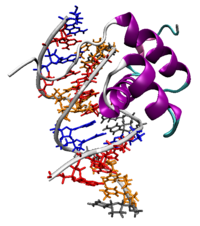
Photo from wikipedia
The morphogenic activity of the Drosophila transcription factor bicoid (Bcd), the first morphogenic protein identified, is controlled by its DNA binding homeodomain. Homeodomains mediate developmental processes in all multicellular organisms,… Click to show full abstract
The morphogenic activity of the Drosophila transcription factor bicoid (Bcd), the first morphogenic protein identified, is controlled by its DNA binding homeodomain. Homeodomains mediate developmental processes in all multicellular organisms, but the Bcd homeodomain appears to be unique as it can bind multiple DNA sequences and even RNA. All homeodomain proteins adopt a three-helix fold, with residues of the third helix mediating recognition of the nucleic acid target via interactions with the major groove. Interestingly, previous studies have revealed that conformational heterogeneity is present in the Bcd residues that interact with bound DNA, suggesting that it may underlie the morphogen's unique polyspecificity. To begin to directly characterize the conformational heterogeneity in the homeodomain, we have introduced C-D bonds within each structural element and characterized their absorptions in the free and bound states, as well as during thermal denaturation. The data reveal that while residues within the first two helices experience unique environments, each environment is well-defined and similar in the presence and absence of bound DNA. In contrast, the data are consistent with residues within the recognition helix adopting multiple conformations, and while the binding of DNA does alter the environments, the conformational heterogeneity is similar in the bound and unbound states. Finally, thermal denaturation studies reveal that the conformational heterogeneity observed in this and previous studies results not from local instability and unfolding, as has been suggested for other transcription factors, but rather from the population of multiple stable conformations within the folded state of the protein. The results have important implications for how Bcd recognizes its different targets to mediate its critical developmental functions.
Journal Title: Biochemistry
Year Published: 2017
Link to full text (if available)
Share on Social Media: Sign Up to like & get
recommendations!